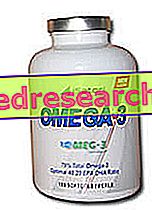
Information on Omega 3 Isatori
OMEGA 3 ISATORI
Food supplement of omega 3 essential fatty acids
FORMAT
Pack of 90/180 pearls
COMPOSITION
Fish oil (standardized in 75% omega 3); capsule (gelatin); emulsifier (glycerol); antioxidant (natural tocopherols)
Nutritional information
Media Analysis | For 1 capsule | For 4 capsules |
Energy value | 8.8 Kcal / 37 Kj | 35 Kcal / 147 Kj |
Lipids | 1 g | 4 g |
of which Saturi | 0 g | 0 g |
Monounsaturated | 0.13 g | 0.5 g |
polyunsaturated | 0.75 g | 3 g |
Concentrated fish oil | 1000 mg | 4 g |
Total Omega 3 | 750 mg | 3 g |
of which EPA | 400 mg | 1.6 g |
DHA | 200 mg | 0.8 g |
Product features Omega 3 Isatori
Product features: this omega 3 supplement offers 1 gram capsules titrated to 75%. More precisely, by carefully reading the label, it is noted as 750 mg per capsule, only 600 mg in total are EPA and DHA, still being among the highest dosage commercial supplements. Important is the presence of tocopherols, natural antioxidants able to protect these fatty acids from lipoperoxidation. Although the company supports the very high quality of this supplement, obtained by multiple molecular distillation, IFOS certification is missing.
Omega 3 fatty acids - fatty acids characterized by the presence of more double bonds, the first of which is present on the third carbon starting from the carbon in omega.

- Anifinammatorio effect: evidenced by the significant reduction of inflammatory markers, and by the protective action against associated pathologies; this mechanism could partly be determined by a modulation of the intracellular signal, and partly by the shift of the equilibrium towards the synthesis of prostaglandins and thromboxanes with anti-inflammatory activity;
- Anti-arrhythmogenic effect: probably associated with the structural role of these substances, which are part of the organization of myocardiocytic membranes;
- Antidiabetic effect (type I diabetes): to be considered with due care, and probably closely related to the protective effect on inflammatory damage in the pancreas;
- Protective effect against psychiatric disorders such as depression, probably guaranteed by the protective action against the central nervous system.
Recent evidence has also identified a new therapeutic and commercial application for alpha linolenic acid, determined by the inhibitory action against the enzyme alpha 5 reductase (responsible for testosterone metabolism and its androgenic effects), which can be transformed into a protective action and preventive useful in the treatment of prostatic hypertrophy and androgenetic alopecia.
Omega 3 and sportsman's well-being
As emerges from the reading of the previous paragraph, omega 3 fatty acids play a particularly important role for human health. Of course, many of these effects are perfectly suited to the needs of the sportsman, and are able to minimize some of the most common exercise-induced damage, many times responsible for a significant drop in the performance and performance of the athlete. In particular:
- The anti-inflammatory action could be useful on the one hand in muscle protection from damage induced by intense physical exercise, on the other hand in the protection of ligament and tendon structures;
- The antiarrhythmogenic and vasodilatory action has proved to be useful in increasing the cardiac ego and in sustaining the oxygenation capacities of the organism during even intense efforts;
- The action on the respiratory system would be able to support the athlete's ventilatory capacities.
Of course, it is important to consider how these effects derive from a supplementation protocol that is adequate to the athlete's needs and that is carried out with the intent to optimize the ratio between omega 6 and omega 3, whose imbalance would determine the onset of various disorders.
Suggested use by the company - Omega 3 Isatori
Take 2-4 capsules a day before a meal
Use in sports - Omega 3 Isatori
The ingestion of 4 capsules per day would guarantee the intake of about 2.4 grams between EPA and DHA, a dosage that is perfectly within the range proposed by the various studies, although in some of these we use daily amounts even higher than 6 grams. The intake should be preferred to main meals, thanks to the "bile-mediated" absorption (necessary given the lipid nature). The integration plan should last for at least 4 weeks, as proposed by the studies. In reality the correct integration should take into account the dietary contribution not only of omega 3, but also of omega 6, since - so that supplementation can be effective - it is necessary to rebalance the relationship between these two forms.
Synergies - Omega 3 Isatori
Several studies show a greater efficacy of action associating to the omega 3 antioxidant substances able to assist the protective action on the stability of the plasma membranes.
Furthermore, for supplementation to guarantee the effects described, it is also necessary that the diet follows the general principles of a healthy diet and is accompanied by controlled exercise.
Omega 3 Isatori side effects
Excessive intake of omega 3 can be associated with immediate phenomena such as nausea, vomiting, gastric and erythema burning, and systemic effects of a different nature.
In the literature, cases of bleeding (due to the anticoagulant action of the omega 3) are described; therefore it is necessary to pay attention to possible interactions with aspirin or other anticoagulants, and in the case of haemophilic pathology or alterations of the glycemic profile in patients suffering from non insulin dependent diabetic pathology.
It should be reiterated that the dose between 2 and 5 grams per day seems to be quite safe, and without the aforementioned side effects.
Precautions for using Omega 3 Isatori
The product is contraindicated in cases of renal or hepatic disease, cardiovascular disease and / or hypertension, allergies and autoimmune diseases, during pregnancy, during breastfeeding, under 12 years and for adolescents not yet trained.
In the event of prolonged use (over 6/8 weeks), medical advice is required.
This article, elaborated on the critical re-reading of scientific articles, university texts and common practice, is for informational purposes only and is therefore not a medical prescription. It is therefore always necessary to consult your doctor, nutritionist or pharmacist before starting to use any kind of supplement . Further information on the critical analysis of Omega 3 Isatori.
| BIBLIOGRAPHY |
J Am Coll Nutr. 2009 Aug; 28 Suppl: 473S-481S. Effect of omega-3 and policosanol supplementation on attention and reactivity in athletes. Fontani G, Lodi L, Migliorini S, Corradeschi F. Int J Sport Nutr Exerc Metab. 2009 Oct; 19 (5): 536-46. n-3 polyunsaturated fatty acidsNieman DC, Henson DA, McAnulty SR, Jin F, Maxwell KR. Nutr Res. 2009 May; 29 (5): 305-12. Cardiovascular risk factors in young, overweight, and obese Europeans and associations with physical activity and omega-3 index.Ramel A, Pumberger C, Martinéz AJ, Kiely M, Bandarra NM, Thorsdottir I. J Sci Med Sport. 2010 Mar; 13 (2): 281-6. Epub 2009 Jun 12. The effects of omega-3 supplementation on pulmonary function of young wrestlers during intensive training.Tartibian B, Maleki BH, Abbasi A. Clin J Sport Med. 2009 Mar; 19 (2): 115-9. Tartibian B, Maleki BH, Abbasi A. Eur J Appl Physiol. 2008 Oct; 104 (3): 455-61. Epub 2008 Jun 18. Omega-3 fatty acid supplementation enhances stroke volume and cardiac output during dynamic exercise.Walser B, Stebbins CL. J Sci Med Sport. 2009 Jul; 12 (4): 503-7. Epub 2008 Jun 13. DHA-rich fish oil lowers heart rate during submaximal exercise in elite Australian Rules footballers.Buckley JD, Burgess S, Murphy KJ, Howe PR. Curr Sports Med Rep. 2007 Jul; 6 (4): 230-6. Omega-3 fatty acids and athletics.Simopoulos AP. Am J Clin Nutr. 2007 Mar; 85 (3): 803-7. Högström M, Nordström P, Nordström A. J Psychiatr Res. 2008 Jan; 42 (1): 58-63. Epub 2006 Oct 30. Omega-3 fatty acids on the forced-swimming test.Huang SY, Yang HT, Chiu CC, Pariante CM, Su KP. Eur J Appl Physiol. 2004 Aug; 92 (4-5): 584-91. Epub 2004 Mar 30. Effect of n-3 fatty acids on free tryptophan and exercise fatigue.Huffman DM, Altena TS, Mawhinney TP, Thomas TR. Crit Care Clin. 2010 Jul; 26 (3): 501-514. Fish Oil in Critical Illness: Mechanisms and Clinical Applications.Stapleton RD, Martin JM, Mayer K. J Alzheimers Dis. 2010 Jul 15. [Epub ahead of print] Omega-3 Fatty Acids, Cognitive Decline, and Alzheimer's Disease: A Critical Review and Evaluation of the Literature.Huang TL. Cardiovasc Ther. 2010 Aug; 28 (4): 202-15. Nutraceuticals and atherosclerosis: human trials.Badimon L, Vilahur G, Padro T. Cell Mol Biol (Noisy-le-grand). 2010 Feb 25; 56 (1): 28-37. Omega-3 (n-3) fatty acids, cardiovascular disease and stability of atherosclerotic plaques.Calder PC, Yaqoob P. BMC Cardiovasc Disord. 2010 Jun 3; 10: 24. Omega-3 fatty acids in high-risk cardiovascular patients: a meta-analysis of randomized controlled trials. |



